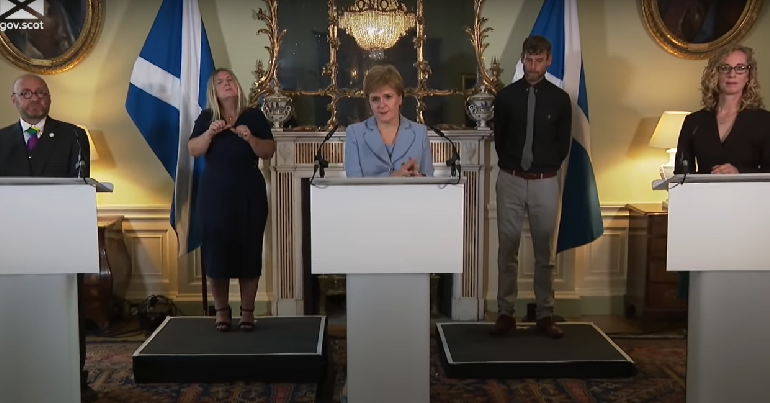How the Scottish Green Party negotiated the cooperation deal with the SNP

I joined a working group at the very first Green meeting I went to. It was an early Ecology Party Malvern conference, and a handwritten notice appeared on the conference noticeboard: “Legalise Cannabis Working Group; Meet under the trees, down by the river. 6pm. Bring your own papers.” Realising this was the party for me, I joined, and enjoyed a mellow conference.
40 years on and I have just concluded my tenure as Co-chair of a very different working group for a very different party. No longer a small pressure group of idealists dreaming, the Scottish Green Party is now considering whether to accept a degree of power and join the SNP in governing Scotland.
This article looks at the process we went through to reach a political co-operation agreement with the government – not the policies.
Our constitution requires us in these circumstance to set up a working group comprised of 11 representatives of branch and key national committees, which we did as soon as we were invited to talks.
Negotiations hinge on manifestos – the documents we are elected on – so the first step was for our parliamentary staff to draw up a comparison of our manifestos, showing our line, the status quo and the SNP’s manifesto proposals on each of our key asks.
We put out a survey to members asking them what their priorities for inclusion were. Unsurprisingly, top of the poll was the environment and combatting climate change.
Then came the meetings. We put 6 key policy areas on the table as our priorities and our parliamentary group went into a series of meetings with Ministers and civil servants. It quickly became obvious that the First Minister had sent her ministers in to negotiate positively – this was likely to be more than a window-dressing confidence and supply arrangement.
We looked in some detail at the experience of the New Zealand Greens, who have had a range of different working arrangements in government, and their leaders very kindly agreed to get up early to speak to a question and answer session for our members.
They recommended; “find 3 key wins you can dine out on at the next election, but keep your right to criticise in other areas of government.” We have journalists as members and this strategy was reported in the press – throughout the two-month process there has been a tension between the democratic desire to keep our members as informed as possible, while ensuring that negotiations are held in confidence to build up trust between the two sides. Members are much more likely to support things they feel they’ve been involved in, but negotiations which aren’t guaranteed to succeed cannot be carried out in public. Nothing was agreed until everything was agreed.
The New Zealanders’ recommendation to seek two ministers who have collective responsibility for the programme, but are free to criticise other aspects, caused some difficulties for the civil servants as this is a new concept in UK politics – but we got there in the end with an excluded list which outlines areas of government where we know there’s never going to be common ground between us and the SNP – such as financial support for aerospace and defence industries. And there’s a detailed process for resolving issues which arise.
Once our proposals had been discussed, and a significant number of them agreed, the government put on the table the areas they wanted included, such as marine protection, child poverty and most importantly their flagship policy to create a National Care Service. Negotiations here were tougher; deadlines were extended and wording not finalised until the night before the final final deadline for the deal to go to the Cabinet for approval. Tracked changes show civil servants working until midnight.
The volume of work surprised us all – 20 meetings over an 8 week period in which we analysed several drafts of 65 pages of agreement line by line and sometimes word by word.
The Scottish Greens’ Constitution requires that such a deal must be approved by an EGM of members and a two-thirds meeting of Council (which is made up of 2 delegates from each branch and Representative Group). Democracy proved a real strength; it wasn’t just our negotiators in the room agreeing to things; they were able to say “we really want this deal – but we’ve got to get this past our members and if they don’t like it, you’ll get no agreement at all.” Definitely recommended!
The deal now goes to members for approval this weekend.
Spurred on by the Code Red for humanity, and the inequities of English Toryism and the need for trans rights, we think it’s time for the Scottish Green Party to take on the responsibilities of power-sharing.
I can remember an SGP annual conference held in a drama rehearsal room, at which around 20 people spent much of the time arguing about whether a Green Government would tax Local Employment Trading Schemes. This Saturday hundreds of members are registered for a conference to decide on whether to go into government to achieve a host of things, such as rent controls and a massive investment in public transport. We’ve come a long way.
Chris Ballance has been co-convenor of the Scottish Green Party Council (2019-21) and co-convenor of the Highlands and Islands Green Party (2020-present).
PS. We hope you enjoyed this article. Bright Green has got big plans for the future to publish many more articles like this. You can help make that happen. Please donate to Bright Green now.
Image credit: YouTube screengrab



Well we’ve taken the plunge now. Not an easy decision but I think the right one if we want to get things done over the next 5 years. We could have waited for a more perfect deal in 5 years time but it might not have been forthcoming and the planet can’t wait.
The Scottish National Party is not a party the Greens should be joining up with at this point. They have been in government since 2007 and are showing the corrupt authoritarian tendancies all groups do when they have been in charge that long. I think the Greens could be dragged down with them like they were with Fianna Fall in Ireland. I certainly would reccomend my scottish friends to look at other parties if this is voted on.
Bring back the ECOLOGY party may be…